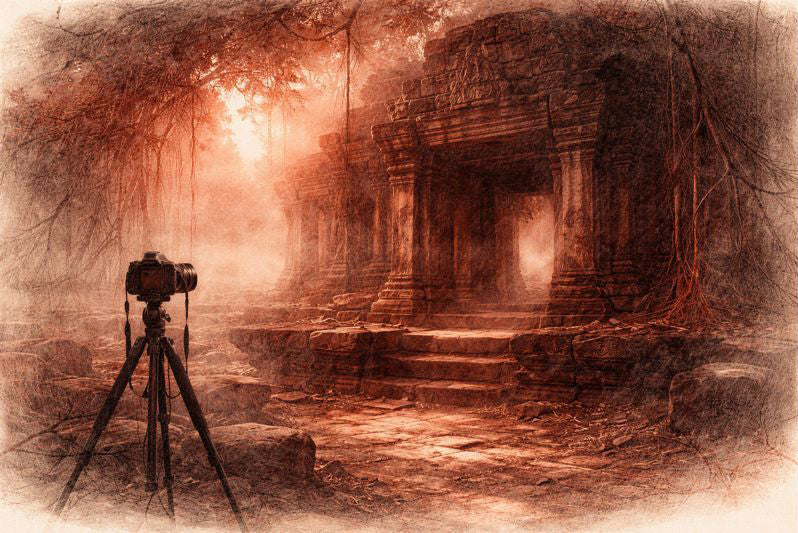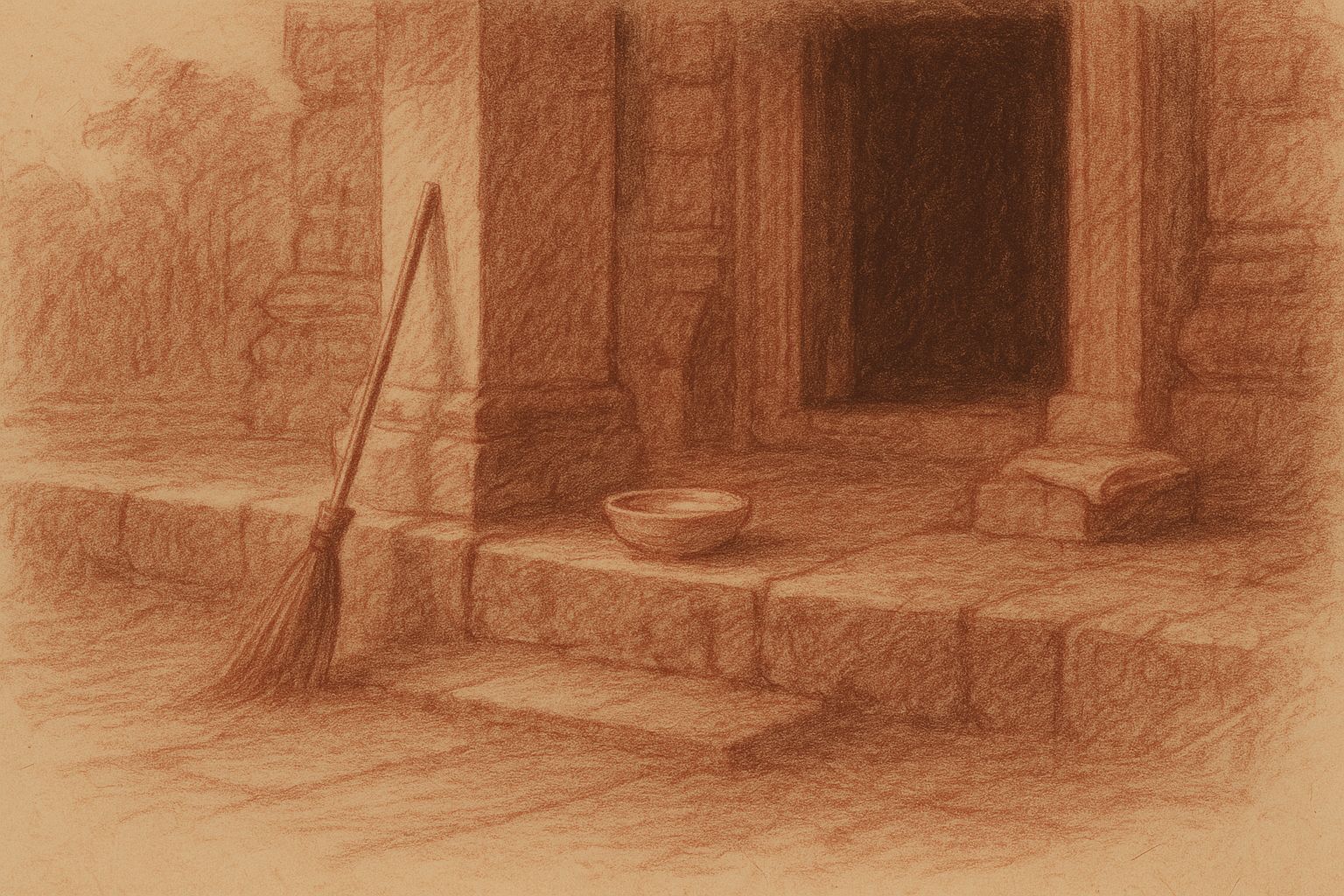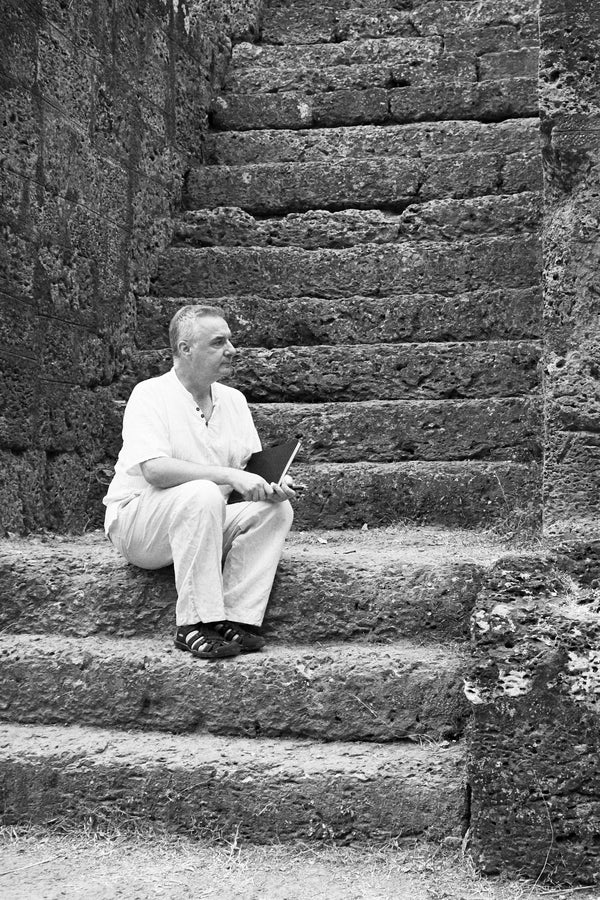Complimentary worldwide shipping on orders over $400 · No import tariffs for most countries
Complimentary worldwide shipping on orders over $400 · No import tariffs for most countries

The God Who Walked Away: Rama in Sacred Stone
Sanctuary of Meaning · Artist’s Journal
Lucas Varro
He wept in the forest,
but did not break the vow—
even for love.
—from a field note beside the Ramayana reliefs at Angkor Wat
—
There is a silence that lingers beneath the roar of battle—a silence older than victory, more lasting than glory. One does not walk the galleries of Angkor Wat merely to witness a tale of war. One comes to remember how love endures, how vows cut deeper than swords, and how the faces of gods are not always serene.
In stone, Rama stands composed. Straight-backed among monkey warriors, he draws his bow with divine calm, leads with unwavering grace. But if you walk these colonnades at dawn, when the bas-reliefs breathe in shadow and gold, you may hear something quieter. Beneath the noise of conquest flows another current: the ache of exile, the heat of self-restraint, the hush of a broken heart still faithful to its path.
The Ramayana at Angkor is not merely a retelling. It is a sacred compression—a cosmic scripture rendered in sandstone. These galleries are not just corridors of narration, but temples of moral paradox, carved thresholds of spiritual fire. Each panel is a window into the mystery of sacrifice.
We begin in a forest of gods and demons. Dasaratha’s longing calls forth the sacrificial flame. From it, Vishnu emerges radiant, bearing divine nectar for the king’s wives. The sons born of this blessing are not mere heirs. They are vessels of destiny—Rama receiving half the god’s essence, his brothers the rest. Yet it is not Rama’s divinity that defines him. It is his humanity.
He is taught and tempered, entrusted with sacred mantras. He bends Shiva’s bow and wins Sita—she who was not born from womb but from furrowed soil, daughter of the earth. In her, Rama finds both his mirror and his undoing: the joy of union, the wound of loss, the unyielding weight of what must be upheld.

He does not aim to win—
but to honour the vow,
and draw the gaze of the earth-born flame.
The tale flows across kingdoms and thresholds—outer geographies and inner awakenings: the exile to Dandaka, the grotesque beauty of the rakshasas, the golden deer that flickers like illusion, the faithful brotherhood that never breaks. Shurpanakha, spurned and wounded, unleashes the fire to come. Hanuman leaps beyond the ocean of doubt. Jatayu dies in midair defending the sacred feminine. Every encounter deepens the tension between power and surrender.
And then, the war.
It is tempting to behold only its grandeur: the bridge across the sea, the thunder of chariots, arrows whispered with mantra. But there is ache at the core of this ending. Ravana does not die in shadow, but in radiance—felled not by rage, but by fate. Rama, though victorious, does not rejoice. The murmur of doubt has begun.
Sita walks through fire and emerges untouched—Agni himself bearing witness to her purity. Yet the world is not satisfied. Whispers persist. And Rama, bound more to law than longing, turns from her again.
She returns to the earth that birthed her. He walks into the river and disappears. If there is such a thing as victory, it lies somewhere between their partings—on ground never dried from her final tears.
At Angkor, the story does not end with coronation. It ends with the long echo of the vow. The stone does not weep. But the gallery grows still.
This is not a tale of moral perfection. Rama is not the god who never faltered. He is the one who bore his faltering with grace. He let the wound remain. He chose duty over comfort, silence over defence. He walked into forest, into fire, into solitude—and never turned away in bitterness.
The Ramayana, as carved by Khmer hands, is a sacred lament—a praise of restraint, a portrait of love too vast to be easy. It does not seek resolution. It offers reverence.
He chose the vow,
though it broke him open.
Still, the forest listened.
—
And even now, the galleries remember.
Also in Library

Before the Shutter Falls
3 min read
Before the shutter falls, fear sharpens and doubt measures the cost of waiting. In the quiet hours before dawn, the act of not-yet-beginning becomes a discipline of attention. This essay reflects on patience, restraint, and the quiet mercy that arrives when outcome loosens its hold.

Those Who Keep the Way Open — On the Quiet Guardians of Angkor’s Thresholds
3 min read
Quiet gestures shape the way into Angkor — a swept stone, a refilled bowl, a hand steadying a guardian lion. This essay reflects on the unseen custodians whose daily care keeps the thresholds open, revealing how sacredness endures not through stone alone, but through those who tend its meaning.

Multiplicity and Mercy — The Face Towers of Jayavarman VII
5 min read
A new vision of kingship rises at the Bayon: serene faces turned to every horizon, shaping a world where authority is expressed as care. Moving through the terraces, one enters a field of steady, compassionate presence — a landscape where stone, light, and time teach through quiet attention.
Join My Studio Journal
Receive occasional letters from my studio in Siem Reap—offering a glimpse into my creative process, early access to new fine art prints, field notes from the temples of Angkor, exhibition announcements, and reflections on beauty, impermanence, and the spirit of place.
No noise. No clutter. Just quiet inspiration, delivered gently.
Subscribe and stay connected to the unfolding story.

Join My Studio Journal
Receive occasional letters from my studio in Siem Reap—offering a glimpse into my creative process, early access to new fine art prints, field notes from the temples of Angkor, exhibition announcements, and reflections on beauty, impermanence, and the spirit of place.
No noise. No clutter. Just quiet inspiration, delivered gently.
Subscribe and stay connected to the unfolding story.
